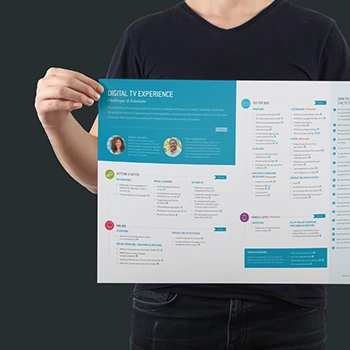What exactly is customer persona research and why do we need it?
Customer persona research uncovers the human characteristics, motivations, and behaviors of your audience through systematic investigation. Using our Experience Thinking framework, we examine how people interact with your brand, content, products, and services to create detailed portraits of your customers. This research reveals not just demographics, but the deeper psychological and contextual factors that drive decision-making.
Tip: Focus on behavioral patterns and motivations rather than just demographic data when defining research objectives.
How do you define customer personas versus user personas?
Customer personas represent people in the buying phase who are evaluating value and making purchase decisions. User personas focus on people who are actively engaging with your product or service to accomplish tasks. The Experience Thinking framework recognizes that the same person moves through customer, user, and client roles across the experience lifecycle, requiring different research approaches for each phase.
Tip: Plan research that captures behaviors across the entire experience lifecycle rather than focusing on just one phase.
What's the difference between personas and demographic profiles?
Demographics describe who people are statistically, while personas reveal how people behave and why they make decisions. Personas include psychographics, contextual factors, goals, pain points, and behavioral patterns that demographics alone cannot capture. Our research shows that demographics and psychographics are often poor predictors of behavior with products and services.
Tip: Prioritize behavioral insights and contextual factors over demographic characteristics when building personas.
How do personas support experience design strategy?
Personas become the foundation for Experience Thinking by ensuring all four quadrants - brand, content, product, and service - align with actual human needs. They provide a shared understanding of the audience that guides strategic decisions across the entire experience ecosystem. Personas help organizations move from product-focused thinking to audience-focused design.
Tip: Use personas as decision-making tools throughout the design process rather than just reference documents.
What research methods do you use to develop customer personas?
Our anthropological approach employs ethnographic interviews, contextual inquiry, participant observation, and journey mapping to understand customer behavior in natural environments. We use iterative interviewing techniques that reveal underlying motivations and cultural factors influencing decisions. Creative research methodologies help uncover insights that traditional approaches might miss.
Tip: Choose research methods that reveal actual behavior in context rather than just stated preferences or intentions.
How many participants do you typically interview for persona development?
Research shows saturation typically occurs after 20 participants, though this varies based on system complexity and persona variance. We generally recommend 3 participants per anticipated persona as a starting point. For organizations with 5 personas, 15 participants provides a robust foundation. Quality of insights matters more than quantity - we focus on recruiting participants who accurately represent your target audience.
Tip: Invest in proper participant recruitment rather than simply increasing numbers to ensure representative findings.
How do you ensure personas represent real customers rather than assumptions?
We ground every persona in actual research data through systematic validation processes. Our anthropological background ensures we observe real behaviors rather than stated preferences. We validate persona characteristics through multiple touchpoints including customer service interactions, purchase behavior analysis, and contextual observation of product usage in natural environments.
Tip: Validate personas against actual customer data and behaviors rather than internal stakeholder assumptions.
What's your process for conducting customer persona research?
Our process begins with stakeholder alignment workshops to understand business objectives and existing customer knowledge. We then design research studies using appropriate qualitative and quantitative methods, recruit representative participants, and conduct systematic data collection. Analysis involves pattern identification, insight synthesis, and persona creation validated through additional research touchpoints.
Tip: Establish clear research objectives and success metrics before beginning data collection.
How long does persona research typically take?
Timeline depends on research scope, participant availability, and complexity of your customer base. Basic persona research takes 6-8 weeks including planning, recruitment, data collection, analysis, and validation. More complex projects involving multiple market segments or international audiences may require 10-12 weeks. We provide regular progress updates and preliminary findings throughout the process.
Tip: Plan buffer time for participant recruitment challenges rather than compressing research timelines.
How do you recruit participants for persona research?
We use systematic recruitment strategies combining your existing customer database, professional recruitment services, and targeted outreach through appropriate channels. Recruitment criteria include behavioral characteristics, contextual factors, and experience with your category rather than just demographics. We screen participants to ensure they represent authentic customer perspectives.
Tip: Define recruitment criteria based on behavioral characteristics relevant to your business rather than broad demographic categories.
What information do you gather during customer interviews?
Interviews explore motivation, decision-making processes, contextual factors, pain points, goals, and behavioral patterns. We investigate how people discover, evaluate, purchase, and use products or services in your category. Through our Experience Thinking lens, we examine interactions across brand, content, product, and service touchpoints to understand holistic experience expectations.
Tip: Prepare interview guides that explore both rational and emotional factors influencing customer behavior.
How do you analyze and synthesize persona research data?
Analysis involves systematic pattern identification across qualitative data including interview transcripts, observation notes, and behavioral evidence. We use affinity mapping, behavioral clustering, and statistical analysis to identify meaningful segments. Our anthropological approach reveals cultural and contextual factors that traditional analysis might miss. Synthesis creates actionable personas grounded in research evidence.
Tip: Look for behavioral patterns and motivational themes rather than just demographic clustering when analyzing data.
How do you validate persona accuracy after creation?
Validation includes additional customer interviews, comparison with actual customer data, stakeholder feedback sessions, and testing persona predictions against real behavior. We often conduct follow-up research to refine persona details and ensure ongoing accuracy. Validation confirms that personas predict actual customer behavior rather than reflecting researcher assumptions.
Tip: Build validation checkpoints into your research plan rather than treating persona creation as a final step.
What role do stakeholders play in the research process?
Stakeholders contribute market knowledge, customer insights, and strategic context during initial workshops and validation sessions. We facilitate stakeholder interviews to understand current customer perceptions and business objectives. However, we balance stakeholder input with independent research to avoid confirmation bias. Stakeholders help interpret findings within business context and strategic priorities.
Tip: Engage stakeholders as research partners while maintaining independence in data collection and analysis.
How many personas should we have?
The optimal number depends on your market complexity, product range, and organizational capacity to act on insights. Most organizations benefit from 3-5 primary personas that represent distinct behavioral patterns and business value. Too many personas create confusion and dilute focus, while too few oversimplify complex markets. We help identify the minimum viable number that captures key behavioral differences.
Tip: Start with fewer, well-researched personas rather than trying to represent every possible customer variation.
How detailed should customer personas be?
Personas should contain sufficient detail to guide design decisions without becoming unwieldy reference documents. Essential elements include goals, motivations, behavioral patterns, contextual factors, pain points, and decision-making processes. Through Experience Thinking, we ensure personas address needs across brand, content, product, and service experiences. Details should be actionable for your specific business context.
Tip: Focus persona details on information that directly impacts design and strategy decisions for your organization.
How do we use personas for product development decisions?
Personas guide feature prioritization, design decisions, and development roadmaps by representing customer needs throughout the product experience. They help development professionals understand user context, validate feature ideas, and resolve design debates through customer perspective. In Experience Thinking terms, personas ensure product experiences align with broader brand and service expectations.
Tip: Reference personas during feature discussions and design reviews rather than storing them in documentation that developers never see.
How do personas inform content strategy and creation?
Personas reveal how different audiences consume information, preferred communication styles, content formats, and information hierarchies. They guide content tone, complexity level, channel selection, and messaging frameworks. Our Experience Thinking approach ensures content personas align with broader brand personality and service experience expectations to create cohesive communication across touchpoints.
Tip: Develop content guidelines that specify tone, complexity, and format preferences for each persona rather than generic content standards.
How do we share personas effectively across our organization?
Effective persona sharing requires formats tailored to different stakeholder needs and regular integration into business processes. We create executive summaries for leadership, detailed profiles for design practitioners, and quick reference cards for broader organizational use. Personas become most effective when integrated into project planning, decision frameworks, and regular business discussions.
Tip: Create multiple persona formats suited to different stakeholder roles rather than expecting everyone to use the same detailed documents.
How often should we update our customer personas?
Persona refresh frequency depends on market volatility, business changes, and customer evolution patterns. Most organizations benefit from annual persona validation with major updates every 2-3 years. However, rapidly changing markets or significant business model shifts may require more frequent updates. We help establish monitoring systems that indicate when persona updates become necessary.
Tip: Monitor key behavioral indicators and market changes rather than updating personas on arbitrary schedules.
Can personas work for B2B customer research?
B2B personas require understanding both individual motivations and organizational contexts that influence decision-making. Research must capture role-based behaviors, company constraints, procurement processes, and stakeholder dynamics. Through Experience Thinking, we examine how B2B customers experience your brand across complex organizational touchpoints and extended decision cycles.
Tip: Include organizational context and decision-making processes in B2B personas rather than focusing solely on individual characteristics.
What strategic insights does persona research typically reveal?
Research reveals unmet needs, market opportunities, customer journey pain points, and competitive differentiation possibilities. We often discover gaps between organizational assumptions and actual customer behavior. Through our Experience Thinking framework, insights span across brand perception, content consumption patterns, product usage contexts, and service experience expectations that shape strategic priorities.
Tip: Prepare for findings that challenge existing assumptions about your customers rather than expecting research to confirm current beliefs.
How do personas reveal market opportunities and gaps?
Personas expose underserved customer segments, unmet needs, and competitive blind spots through systematic behavior analysis. Research reveals where current market solutions fail to address customer motivations or contextual factors. We identify opportunities for experience innovation across brand positioning, content strategy, product features, and service delivery that competitors may be overlooking.
Tip: Focus on behavioral gaps and unmet needs rather than feature comparisons when identifying market opportunities.
How do customer personas inform competitive strategy?
Personas reveal how your audience evaluates alternatives, decision-making criteria, and competitive perceptions across the experience lifecycle. Research shows where competitors succeed or fail in addressing persona needs, creating opportunities for differentiation. Through Experience Thinking, we analyze competitive experiences across all four quadrants to identify strategic positioning opportunities.
Tip: Analyze competitive strengths and weaknesses through your specific customer lens rather than general market analysis.
What business impact do well-researched personas typically create?
Organizations report improved conversion rates, reduced development waste, better customer satisfaction, and clearer strategic direction when personas guide decision-making. Research-based personas help prioritize features that matter most to customers, improve marketing effectiveness, and reduce costly design iterations. Experience Thinking ensures persona impact extends beyond single touchpoints to drive holistic experience improvement.
Tip: Establish baseline metrics before persona implementation to measure research impact on business outcomes.
How do personas support customer-centric organizational transformation?
Personas provide shared customer understanding that aligns departments around common audience insights. They create customer empathy across engineering, marketing, sales, and support functions by making abstract customer concepts tangible and actionable. In Experience Thinking terms, personas ensure all four experience quadrants work together to serve consistent customer needs rather than optimizing individual touchpoints in isolation.
Tip: Use personas as alignment tools in cross-functional meetings rather than keeping them isolated within design contexts.
How do personas help prioritize feature development and roadmap planning?
Personas provide objective criteria for evaluating feature ideas based on customer value rather than internal preferences. They help resolve product debates by referencing actual customer needs and contexts. Through systematic persona analysis, organizations can sequence development priorities that deliver the most impact for their most valuable customer segments.
Tip: Create feature scoring frameworks based on persona goals and pain points rather than relying on stakeholder opinion for prioritization decisions.
What role do personas play in customer experience strategy?
Personas anchor experience strategy in human reality rather than business assumptions. They reveal the connected experience journey from awareness through advocacy, showing how customers move between roles over time. Using Experience Thinking, personas ensure strategy addresses the complete experience ecosystem - brand interactions, content consumption, product usage, and service touchpoints - as an integrated system.
Tip: Map personas against your entire experience ecosystem to identify strategic gaps between current state and customer expectations.
What qualitative research methods do you use for persona development?
Our anthropological approach employs ethnographic interviews, contextual inquiry, participant observation, and journey mapping to understand customer behavior in natural environments. We use iterative interviewing techniques that reveal underlying motivations and cultural factors influencing decisions. Creative research methodologies help uncover insights that traditional approaches might miss.
Tip: Choose research methods that reveal actual behavior in context rather than just stated preferences or intentions.
How do you balance qualitative insights with quantitative data?
Qualitative research reveals why customers behave certain ways, while quantitative data shows patterns and scale. We integrate survey data, analytics, customer database analysis, and behavioral metrics with interview insights to create robust personas. This mixed-method approach ensures personas represent both statistical reality and human understanding.
Tip: Use quantitative data to validate qualitative patterns rather than treating them as separate research streams.
How do you ensure research captures diverse customer perspectives?
Systematic recruitment strategies ensure representation across relevant behavioral segments, geographic markets, and demographic categories. We actively seek diverse perspectives and use inclusive research methods that accommodate different communication styles and accessibility needs. Our approach recognizes that diverse perspectives often reveal insights that majority viewpoints miss.
Tip: Define diversity criteria based on factors relevant to your business rather than generic demographic representation.
What's your approach to international or multicultural persona research?
International research requires understanding cultural contexts, local market conditions, and behavioral variations across geographic regions. We adapt research methods to respect cultural differences while maintaining consistency in insight quality. Through Experience Thinking, we examine how cultural factors influence expectations across brand, content, product, and service experiences in different markets.
Tip: Partner with local research professionals who understand cultural nuances rather than applying standardized methods across all markets.
How do you handle sensitive topics or private customer information?
Research design includes privacy protection, informed consent, and ethical data handling throughout the process. We create safe spaces for participants to share honest perspectives while protecting their identity and personal information. Research protocols ensure compliance with privacy regulations while maintaining the depth of insight needed for effective personas.
Tip: Establish clear privacy and ethical guidelines before beginning research rather than addressing concerns reactively.
What technology and tools do you use for persona research?
We use professional research tools for interview recording, transcription, data analysis, and insight synthesis. Technology supports rather than replaces human insight - our researchers bring behavioral science expertise, anthropological methods, and design thinking to interpret data meaningfully. We're exploring AI integration for pattern identification while maintaining human judgment for strategic insights.
Tip: Focus on research methodology and human expertise rather than specific technology platforms when evaluating research approaches.
How do you maintain research quality and avoid bias?
Quality assurance includes systematic methodology, diverse perspective inclusion, multiple validation points, and independent analysis verification. Our researchers bring behavioral science training that includes bias recognition and mitigation strategies. We use structured analysis approaches and multiple researcher perspectives to ensure findings reflect customer reality rather than researcher assumptions.
Tip: Plan multiple validation touchpoints throughout the research process rather than relying on single-point verification.
How do personas integrate with our existing business processes?
Successful integration requires embedding personas into decision-making workflows, planning processes, and performance measurement systems. We help organizations adapt existing processes to include persona considerations rather than creating separate research workflows. Integration spans strategy development, product planning, marketing campaigns, and customer service protocols.
Tip: Integrate personas into existing workflows and decision points rather than creating separate research processes that operate in isolation.
How do personas support marketing and brand strategy?
Personas reveal brand perception, communication preferences, channel behaviors, and messaging resonance patterns that inform marketing strategy. Through Experience Thinking, personas ensure brand experiences align with customer expectations and emotional drivers. They guide campaign development, channel selection, content creation, and brand positioning to create authentic connections with target audiences.
Tip: Use personas to evaluate marketing effectiveness through customer perspective rather than just performance metrics.
How do customer service focus on persona insights?
Service personas reveal communication preferences, problem-solving approaches, emotional triggers, and support channel preferences that improve customer interactions. They help service representatives understand customer context and adapt their approach accordingly. Through Experience Thinking, service personas connect to broader brand and product experiences to ensure consistent customer treatment.
Tip: Train service representatives to recognize persona characteristics during customer interactions rather than just providing static reference materials.
How do personas influence sales strategy and approaches?
Sales personas reveal decision-making processes, evaluation criteria, objection patterns, and relationship preferences that inform sales methodology. They help sales professionals understand customer context and adapt their approach to match persona communication styles and decision frameworks. Personas guide qualification criteria and sales process optimization.
Tip: Develop persona-specific sales tools and conversation guides rather than using generic sales approaches for all customers.
What training do you provide for using personas effectively?
Training includes persona interpretation workshops, application exercises, and integration planning sessions tailored to different organizational roles. We help organizations understand how to reference personas during decision-making and avoid common persona misuse patterns. Training ensures personas become decision-making tools rather than decorative documentation.
Tip: Focus training on practical application scenarios specific to each department's daily decisions rather than general persona awareness.
How do you measure persona effectiveness and business impact?
Measurement includes tracking decision-making improvements, customer satisfaction changes, product success metrics, and organizational alignment indicators. We establish baseline measurements before persona implementation and monitor changes in customer-centric decision-making across the organization. Through Experience Thinking, we measure impact across all customer touchpoints rather than isolated metrics.
Tip: Define specific behavioral changes you expect from persona implementation rather than just measuring awareness or usage statistics.
How do personas scale across large or complex organizations?
Scaling requires governance frameworks, standardized formats, and systematic training approaches that maintain persona quality while enabling organizational adoption. We develop persona management systems, update protocols, and usage guidelines that work across diverse departments and geographic locations. Success depends on balancing consistency with local adaptation needs.
Tip: Create persona governance systems that specify what can be adapted locally versus what must remain consistent globally.
What deliverables do we receive from persona research?
Deliverables include detailed persona profiles, research methodology documentation, supporting data analysis, implementation guidelines, and presentation materials for stakeholder communication. We provide both detailed reference documents and practical summary formats designed for daily use. All deliverables are designed for easy sharing and practical application by your organization.
Tip: Specify deliverable formats that match your organization's existing documentation standards and workflow requirements.
How do you format personas for different organizational audiences?
We create persona formats tailored to specific stakeholder needs - executive summaries for leadership, detailed profiles for design practitioners, and quick reference cards for broader organizational use. Different formats emphasize relevant information for each audience while maintaining consistency in core persona characteristics. Format variations ensure widespread adoption across organizational levels.
Tip: Plan persona formats for actual usage contexts rather than creating one-size-fits-all documentation that nobody uses effectively.
What supporting research documentation do you provide?
Supporting documentation includes research methodology, data collection instruments, analysis frameworks, participant profiles, and validation evidence. We provide transparency into research processes and findings that allow organizations to understand persona foundations and make informed decisions about research application. Documentation supports internal communication and future research planning.
Tip: Use research documentation to build internal confidence in persona accuracy rather than just satisfying documentation requirements.
How do you present persona research findings to stakeholders?
Presentations combine persona profiles with strategic insights, implementation recommendations, and business implications tailored to audience interests. We use storytelling techniques that make personas memorable and actionable rather than just informational. Presentations include interaction opportunities for stakeholders to explore persona applications to their specific business challenges.
Tip: Focus presentations on business implications and next steps rather than just persona characteristics and research methodology details.
What implementation guidance do you provide with persona deliverables?
Implementation guidance includes specific recommendations for using personas in decision-making, process integration suggestions, training materials, and success measurement frameworks. We help organizations translate persona insights into actionable business strategies across marketing, product development, customer service, and sales functions. Guidance is customized to organizational context and capability.
Tip: Plan implementation support that addresses your organization's specific adoption challenges rather than generic persona usage advice.
How do you help organizations transition from assumptions to persona-driven decisions?
Transition support includes change management strategies, decision framework development, and coaching for leadership in persona adoption. We help organizations identify where assumptions currently drive decisions and provide alternative persona-based approaches. Success requires demonstrating persona value through pilot projects and gradual adoption rather than immediate wholesale changes.
Tip: Start persona adoption with high-visibility pilot projects that can demonstrate clear value rather than attempting organization-wide implementation immediately.
What ongoing support do you provide after persona delivery?
Ongoing support includes validation studies, application coaching, update planning, and strategic consultation as business needs evolve. We help organizations maximize persona value through continued research collaboration and methodology refinement. Support ensures personas remain accurate and useful as customer behaviors and business contexts change over time.
Tip: Plan ongoing persona maintenance and validation rather than treating initial research as a complete solution.
How do you research personas for emerging or innovative products?
Emerging product research requires understanding latent needs, adoption patterns, and behavioral analogies rather than existing usage patterns. We use forward-looking research methods including scenario planning, prototype testing, and early adopter analysis. Through Experience Thinking, we examine how innovative products might fit into existing brand, content, and service experiences.
Tip: Research customer problems and contexts rather than product features when developing personas for innovative solutions.
How do personas support digital transformation initiatives?
Digital transformation personas reveal how customers adapt to technology changes, preferred interaction patterns, and support needs during transitions. Research examines both current and desired future behaviors to guide transformation strategy. Through Experience Thinking, personas ensure digital initiatives align with customer expectations across brand, content, product, and service experiences.
Tip: Research both current customer behaviors and change readiness when planning digital transformation rather than just future-state preferences.
How do you research personas for complex customer ecosystems?
Complex ecosystems require understanding multiple stakeholder roles, decision-making processes, and interaction patterns between different persona types. Research maps influence relationships, information flow, and collaborative behaviors within customer organizations. We examine how personas interact with each other and influence collective decision-making processes.
Tip: Map stakeholder relationships and influence patterns rather than researching individual personas in isolation for complex organizational customers.
How do personas inform accessibility and inclusive design?
Inclusive persona research examines diverse ability levels, technology access patterns, and interaction preferences to ensure experiences work for broad audiences. We investigate assistive technology usage, cognitive differences, and accessibility barriers that standard persona research might overlook. Research ensures personas represent real diversity rather than idealized customer segments.
Tip: Include accessibility considerations in persona research from the beginning rather than adding them as afterthoughts.
How do you address privacy concerns in persona research?
Privacy protection includes anonymization protocols, secure data handling, informed consent processes, and minimal data collection principles. We ensure persona research complies with privacy regulations while maintaining insight quality. Participants understand how their information will be used and have control over their contribution to research outcomes.
Tip: Establish clear privacy protocols and participant consent processes before beginning any persona research activities.
How do personas support service design and journey optimization?
Service personas reveal interaction preferences, support needs, communication styles, and relationship expectations that inform service design. Through Experience Thinking, service personas connect to brand promises, content delivery, and product experiences to create coherent service experiences. They guide staff training, process design, and touchpoint optimization across the service journey.
Tip: Use service personas to design employee interactions and support processes rather than just customer-facing service elements.
How does AI impact customer persona research and development?
AI enhances persona research through pattern identification in large datasets, automated transcription and initial analysis, and hypothesis generation from behavioral data. However, human expertise remains crucial for understanding motivation, cultural context, and strategic implications. We use AI to augment research capability while maintaining human insight and judgment for persona development and application.
Tip: Use AI to enhance research analysis and efficiency rather than replace human understanding of customer motivations and strategic implications.
How do personas evolve as businesses and markets change?
Persona evolution requires monitoring customer behavior changes, market shifts, competitive landscape developments, and business model adaptations. We establish tracking systems that identify when persona updates become necessary and guide research to understand evolving customer needs. Evolution is managed systematically rather than reactive to maintain persona accuracy and business relevance.
Tip: Monitor persona relevance through customer behavior trends rather than waiting for obvious misalignment before updating research.
How do personas integrate with Experience Thinking framework?
Experience Thinking uses personas to ensure coherent experiences across all four quadrants - brand, content, product, and service. Personas reveal how customers experience your organization holistically rather than through isolated touchpoints. This framework ensures persona insights guide connected experience design that drives customer loyalty and business outcomes through systematic experience lifecycle planning.
Tip: Apply personas across your entire experience ecosystem rather than limiting them to single touchpoints or business functions.












